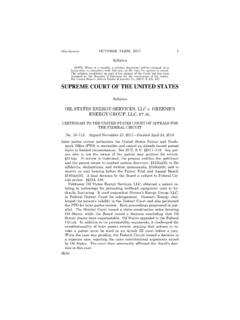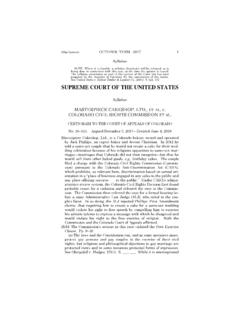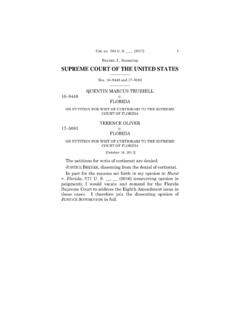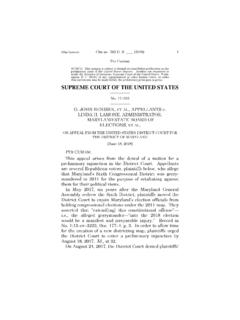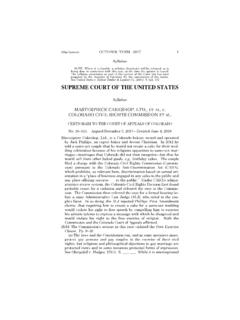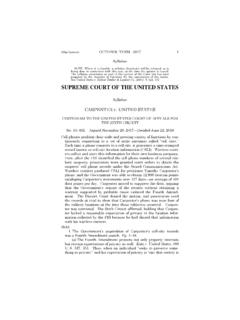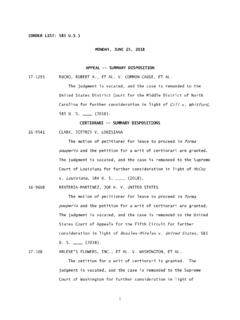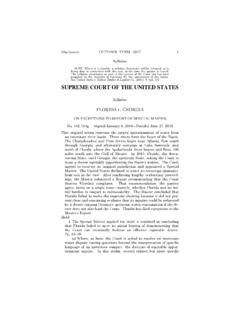Transcription of SUPREME COURT OF THE UNITED STATES
1 (Slip Opinion) OCTOBER TERM, 2014 1. Syllabus NOTE: Where it is feasible, a syllabus (headnote) will be released, as is being done in connection with this case, at the time the opinion is issued. The syllabus constitutes no part of the opinion of the COURT but has been prepared by the Reporter of Decisions for the convenience of the reader. See UNITED STATES v. Detroit Timber & Lumber Co., 200 U. S. 321, 337. SUPREME COURT OF THE UNITED STATES . Syllabus obergefell ET AL. v. HODGES, DIRECTOR, OHIO DEPARTMENT OF HEALTH, ET AL. CERTIORARI TO THE UNITED STATES COURT OF APPEALS FOR.
2 THE SIXTH CIRCUIT. No. 14 556. Argued April 28, 2015 Decided June 26, 2015*. Michigan, Kentucky, Ohio, and Tennessee define marriage as a union between one man and one woman. The petitioners, 14 same-sex cou- ples and two men whose same-sex partners are deceased, filed suits in Federal District Courts in their home STATES , claiming that re- spondent state officials violate the Fourteenth Amendment by deny- ing them the right to marry or to have marriages lawfully performed in another State given full recognition. Each District COURT ruled in petitioners' favor, but the Sixth Circuit consolidated the cases and reversed.
3 Held: The Fourteenth Amendment requires a State to license a mar- riage between two people of the same sex and to recognize a marriage between two people of the same sex when their marriage was lawful- ly licensed and performed out-of-State. Pp. 3 28. (a) Before turning to the governing principles and precedents, it is appropriate to note the history of the subject now before the COURT . Pp. 3 10. (1) The history of marriage as a union between two persons of the opposite sex marks the beginning of these cases. To the respond- ents, it would demean a timeless institution if marriage were extend- ed to same-sex couples.
4 But the petitioners, far from seeking to de- value marriage, seek it for themselves because of their respect and need for its privileges and responsibilities, as illustrated by the pe- . * Together with No. 14 562, Tanco et al. v. Haslam, Governor of Ten- nessee, et al., No. 14 571, DeBoer et al. v. Snyder, Governor of Michigan, et al., and No. 14 574, Bourke et al. v. Beshear, Governor of Kentucky, also on certiorari to the same COURT . 2 obergefell v. HODGES. Syllabus titioners' own experiences. Pp. 3 6. (2) The history of marriage is one of both continuity and change.
5 Changes, such as the decline of arranged marriages and the aban- donment of the law of coverture, have worked deep transformations in the structure of marriage, affecting aspects of marriage once viewed as essential. These new insights have strengthened, not weakened, the institution. Changed understandings of marriage are characteristic of a Nation where new dimensions of freedom become apparent to new generations. This dynamic can be seen in the Nation's experience with gay and lesbian rights. Well into the 20th century, many STATES condemned same-sex intimacy as immoral, and homosexuality was treated as an illness.
6 Later in the century, cultural and political developments al- lowed same-sex couples to lead more open and public lives. Extensive public and private dialogue followed, along with shifts in public atti- tudes. Questions about the legal treatment of gays and lesbians soon reached the courts, where they could be discussed in the formal dis- course of the law. In 2003, this COURT overruled its 1986 decision in Bowers v. Hardwick, 478 U. S. 186, which upheld a Georgia law that criminalized certain homosexual acts, concluding laws making same- sex intimacy a crime demea[n] the lives of homosexual persons.
7 Lawrence v. Texas, 539 U. S. 558, 575. In 2012, the federal Defense of Marriage Act was also struck down. UNITED STATES v. Windsor, 570. U. S. ___. Numerous same-sex marriage cases reaching the federal courts and state SUPREME courts have added to the dialogue. Pp. 6 . 10. (b) The Fourteenth Amendment requires a State to license a mar- riage between two people of the same sex. Pp. 10 27. (1) The fundamental liberties protected by the Fourteenth Amendment's Due Process Clause extend to certain personal choices central to individual dignity and autonomy, including intimate choic- es defining personal identity and beliefs.
8 See, , Eisenstadt v. Baird, 405 U. S. 438, 453; Griswold v. Connecticut, 381 U. S. 479, 484 486. Courts must exercise reasoned judgment in identifying in- terests of the person so fundamental that the State must accord them its respect. History and tradition guide and discipline the inquiry but do not set its outer boundaries. When new insight reveals dis- cord between the Constitution's central protections and a received le- gal stricture, a claim to liberty must be addressed. Applying these tenets, the COURT has long held the right to marry is protected by the Constitution.
9 For example, Loving v. Virginia, 388. U. S. 1, 12, invalidated bans on interracial unions, and Turner v. Safley, 482 U. S. 78, 95, held that prisoners could not be denied the right to marry. To be sure, these cases presumed a relationship in- Cite as: 576 U. S. ____ (2015) 3. Syllabus volving opposite-sex partners, as did Baker v. Nelson, 409 U. S. 810, a one-line summary decision issued in 1972, holding that the exclusion of same-sex couples from marriage did not present a substantial fed- eral question. But other, more instructive precedents have expressed broader principles.
10 See, , Lawrence, supra, at 574. In assessing whether the force and rationale of its cases apply to same-sex cou- ples, the COURT must respect the basic reasons why the right to marry has been long protected. See, , Eisenstadt, supra, at 453 454. This analysis compels the conclusion that same-sex couples may ex- ercise the right to marry. Pp. 10 12. (2) Four principles and traditions demonstrate that the rea- sons marriage is fundamental under the Constitution apply with equal force to same-sex couples. The first premise of this COURT 's rel- evant precedents is that the right to personal choice regarding mar- riage is inherent in the concept of individual autonomy.
